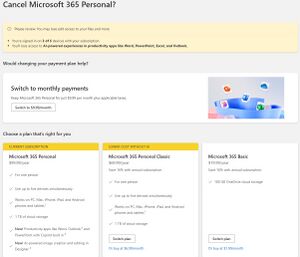Microsoft Office 365: Difference between revisions
→Microsoft Copilot on by default(Word, PowerPoint, Excel): added missing space |
Sarcasm7406 (talk | contribs) Added a section going over how to avoid the price increase for the Microsoft 365 Personal subscription plan. |
||
| Line 1: | Line 1: | ||
{{Incomplete|Issue 1= All issues in this article need sources (| Issue 2= }} | {{Incomplete|Issue 1= All issues in this article need sources (| Issue 2= }} | ||
'''[[wikipedia:Microsoft_365|Microsoft 365]]''' is a family of software, including Microsoft Word, Microsoft PowerPoint, and Microsoft Excel. The branding '''Office 365''' was introduced in 2010 to refer to its subscription-based [[software as a service]], including hosted services such as Office on the web. | '''[[wikipedia:Microsoft_365|Microsoft 365]]''' is a family of software, including Microsoft Word, Microsoft PowerPoint, and Microsoft Excel. The branding '''Office 365''' was introduced in 2010 to refer to its subscription-based [[software as a service]], including hosted services such as Office on the web. | ||
== How to avoid Price Increase (At least for Microsoft 365 Personal Subscriptions) == | |||
[[File:Screenshot 2025-04-05 205541.jpg|thumb|Cancel Microsoft 365 Personal Screenshot, showing the cheaper subscription plan]] | |||
If you currently have a "Microsoft 365 Personal" subscription, and don't want to pay the $30 price increase, there is a way to "revert" back to the $69.99 subscription. Sign in to your Microsoft account, and go to your current subscriptions. Click on your "Microsoft 365 Personal" subscription, then click on cancel subscription. It will then give you the option to switch to the "Microsoft 365 Personal Classic" subscription (see image to right for reference), which is Microsoft's new name for what was the "Microsoft 365 Personal" subscription. There is a [https://www.reddit.com/r/microsoft/comments/1i7jrek/microsoft_365_personal_goes_up_in_price_by_30/ reddit thread] on how to do this, which is linked if you want to read through it as well. | |||
==Consumer Impact Summary== | ==Consumer Impact Summary== | ||
{{Placeholder box|Overview of concerns that arise from the conduct towards users of the product (if applicable): | {{Placeholder box|Overview of concerns that arise from the conduct towards users of the product (if applicable): | ||
Latest revision as of 01:05, 6 April 2025
⚠️ Article status notice: This article has been marked as incomplete
This article needs additional work to meet the wiki's Content Guidelines and be in line with our Mission Statement for comprehensive coverage of consumer protection issues. In particular:
- All issues in this article need sources (
This notice will be removed once the issue/s highlighted above have been addressed and sufficient documentation has been added to establish the systemic nature of these issues. Once you believe the article is ready to have its notice removed, visit the discord and post to the #appeals channel.
Learn more ▼
Microsoft 365 is a family of software, including Microsoft Word, Microsoft PowerPoint, and Microsoft Excel. The branding Office 365 was introduced in 2010 to refer to its subscription-based software as a service, including hosted services such as Office on the web.
How to avoid Price Increase (At least for Microsoft 365 Personal Subscriptions)[edit | edit source]

If you currently have a "Microsoft 365 Personal" subscription, and don't want to pay the $30 price increase, there is a way to "revert" back to the $69.99 subscription. Sign in to your Microsoft account, and go to your current subscriptions. Click on your "Microsoft 365 Personal" subscription, then click on cancel subscription. It will then give you the option to switch to the "Microsoft 365 Personal Classic" subscription (see image to right for reference), which is Microsoft's new name for what was the "Microsoft 365 Personal" subscription. There is a reddit thread on how to do this, which is linked if you want to read through it as well.
Consumer Impact Summary[edit | edit source]
Incidents[edit | edit source]
Microsoft Copilot on by default (Word, PowerPoint, Excel)[edit | edit source]
In the current version of Office 365, Microsoft Copilot is turned on by default. It can be turned off in some of the Office applications' options (Word, Excel, but not PowerPoint, though Microsoft say they'll add the "off" button to PowerPoint in February 2025).
Forced upsell[edit | edit source]
In January 2025, YouTuber Atomic Shrimp reported[1] that Microsoft had enacted a "forced upsell" of 365's new AI Copilot feature. Users with basic accounts (now called "Classic"), such as Shrimp himself, had been informed their subscription fee was going up, but that they would enjoy new features as a result, including Copilot. In his efforts to disable Copilot, Shrimp subsequently discovered that Microsoft now offered "Classic" plans, identical to the old basic plans both in features and in subscription fee. The option to downgrade to Classic, however, was only visible to enterprise users, not to personal users. In essence Microsoft upgraded users' plans without their consent and disabled the option to downgrade, forcing the user to contact Microsoft support in order to opt out of the newly introduced Copilot AI features. The forceful upgrade was at the user's expense, and the downgrading process through support, according to Shrimp, was very time consuming. It is possible to downgrade a personal account through the website without contacting support. If you go to the first page of the cancellation process, there should be an option to downgrade to the "Classic" plan.
Obfuscation of local saving in favor of OneDrive (Word, PowerPoint, Excel)[edit | edit source]
Because of OneDrive, since the introduction of Office 365, saving files locally has been getting more and more difficult to do. Previously, the user would get the expected saving dialog with a pop-up to browse their computer and choose a file-storage location. This is now multiple clicks away, making it harder to avoid saving the file on OneDrive, Microsoft's cloud service.
Files on one's computer are also automatically uploaded to OneDrive by default, causing numerous issues (such as synchronization errors and duplicate files) Turning off this automatic backup is also of considerable difficulty, as one has to navigate a number of settings to get to this option.
To mitigate this somewhat, user can go into Options > Save > Set the check mark on "save locally as default". It still takes multiple clicks to save a file, but the cloud options are at least a bit less intrusive.
Forced Diagnostic Data Transmission[edit | edit source]
Versions other than the Enterprise or Education volume licensing editions do not allow turning telemetry off fully. Moreover, the setting is configured to the least private setting by default.
Office transmits data about 23 000 to 25 000 different types of events[2] (other reports in context of the German BSI audit speak of 30 000 types of events) to Microsoft. Microsoft can adjust the level of detail transmitted remotely. This can go up to every single keystroke being broadcast live to Microsoft servers in the background.
Given that it is not uncommon in some countries even for hospital to run consumer versions of the software, the privacy implications are tremendous. It cannot reasonably be assumed that any data entered into nor any interaction with a Microsoft Office application will stay private.
